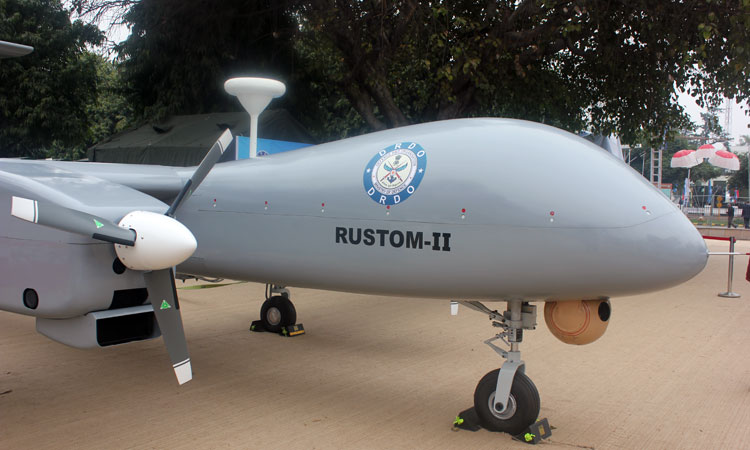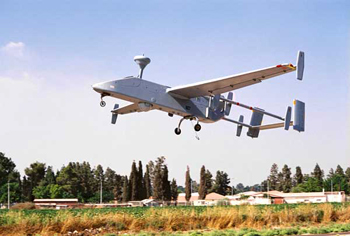INDIAN ARMED FORCES CHIEFS ON
OUR RELENTLESS AND FOCUSED PUBLISHING EFFORTS

SP Guide Publications puts forth a well compiled articulation of issues, pursuits and accomplishments of the Indian Army, over the years

I am confident that SP Guide Publications would continue to inform, inspire and influence.

My compliments to SP Guide Publications for informative and credible reportage on contemporary aerospace issues over the past six decades.
Coming — Armed drones
 |
By Lt. General P.C. Katoch (Retd) Former Director General of Information Systems, Indian Army |


Pakistan tested its indigenous ‘Burraq’ UCAV last year and according to the Dawn quoting industry insiders, in 2015 China had offered to sell Pakistan its CH-3 UCAV, which can carry two laser-guided missiles or bombs. Now in November 2016, China has opened global export for the CH-5 combat drone with transfer of technology; China’s mightiest military drone in terms of operational endurance and payload capacity. The CH-5 had made its first flight in August 2015. The drone made of composite materials has a wingspan of 21 meters. It can stay airborne for 60 hours and operate at an altitude of up to 10 km. Its current maximum range is 6,500 km, and next upgrade aims to enable flying range of 10,000 km. It can carry airborne early warning system, as well as electronic warfare instruments. With a payload of 1,000 kg of equipment and weapons, it can carry 16 air-to-surface missiles. China plans to develop advanced version of CH-5 capable of staying in the air for up to 120 hours, with a 20,000-km range.
In our case, recent media reports quoting MoD sources indicate that the military has prepared detailed blueprint for procuring unattended aerial vehicles (UAVs) over the next decade; some 5000 UAVs are to be procured through the ‘Make in India’ initiative, indigenously through joint ventures (JVs) with foreign companies at an estimated cost of US$3 billion. Currently, the military only operates UAVs imported from Israel (Searcher Mark I, Searcher Mark II, Heron and Heron), in addition to DRDO developed Nishant UAV. Now the Army, Navy and Air Force plan to buy tactical UAVs, high-altitude long-endurance (HALE) UAVs, vertical take-off and landing (VTOL) UAVs, and medium-altitude, long-endurance (MALE) UAVs. So far, the development of UAVs was restricted to the DRDO establishment that witnessed prolonged delays, many hiccups and several crashes in developing the indigenous ‘Nishant’, which at one time was being junked altogether. The military’s requirement of UAVs has suffered past several years because of lack of industrial expertise, combined with delays and cost overruns. This has also adversely affected border surveillance in face of concerted Pakistani attempts for infiltrating terrorists into India. In the next three to five years, the Army proposes to equip UAVs down to the battalion level, while the Air Force plans to have fully operational squadrons of surveillance UAVs and unmanned combat aerial vehicles (UCAV). The plan includes the induction multiple man-portable mini and micro UAVs for short-range surveillance, and nuclear, biological, chemical detection in the battlefield. According to MoD sources, the private sector will be involved in a big in future to meet overall requirements of UAVs; in the next two years fresh tenders are to be floated for a variety of UAVs and that a concept study has commenced for developing a bomber UAV and a fighter UAV.
In Apr 2016, Elbit Systems of Israel formed a JV with Adani Aero Defence and Alpha Design Technologies to cooperate in offering the Hermes 450 and Hermes 900 UAVs to the Indian armed force. According to Israeli sources, this JV will include manufacture at a production facility in India for the airframes and payloads. This followed the announcement by Rafael in March 2016 that it had formed a JV with Reliance Defence to offer aerial systems for the Indian market. On 7 November 2016, formation of the JV named Adani-Elbit Advanced Systems India Limited (AEASIL) was officially announced by Adani Enterprises to produce aerial systems. Meanwhile, DRDO’s Rustom-2 UAV was successfully test flown on November 15 in Challakere, about 200 km from Bengaluru. Rustom-2, claimed to be Unmanned Combat Air Vehicle (UCAV) in the medium-altitude is long endurance (MALE) category of platform reportedly has met all expectations as per DRDO officials though its first scheduled flight in 2013 did not materialize. Rustom-2 has a wingspan of 20m and an endurance of 24-30 hours, as opposed to Rustom-1 which has an endurance of 12 hours and Rustom-H having an endurance of 24 hours. DRDO had earlier stated, major programs that had been finalized for the Army include induction of 500 mini and macro UAVs and an unspecified number of HALE UAVs; for the Air Force an unspecified number of UCAVs, 95 micro unmanned aerial systems and an unspecified number of small VTOL and mini unmanned aerial systems; for the Navy are 95 micro unmanned aerial systems and unspecified numbers of HALE UAVs costing around $200 million. But despite all the tall claims of provisioning the Indian military with UCAVs, DRDO has finally admitted that Rustom-2 will not be converted into a UCAV ‘combat’ drone; DRDO is unable to integrate missiles with the Rustom series of drones. MoD has therefore signed a final US$400 million contract with Israeli Aerospace Industries for importing 10 x Heron TP UCAVs during the recent visit of the Israeli President to India. Delivery of these UCAVs is likely to commence in early 2019. We need to accelerate production of indigenous UCAVs through ‘Make in India’.





